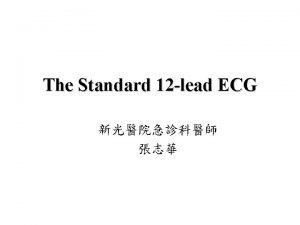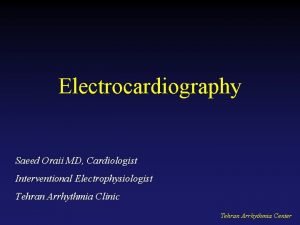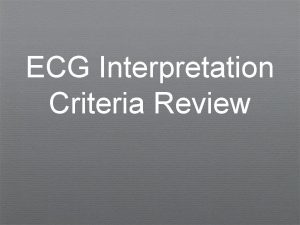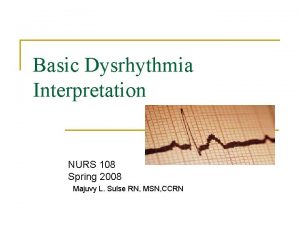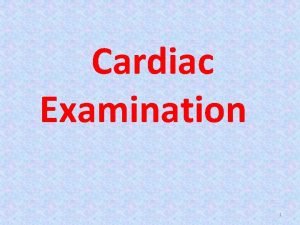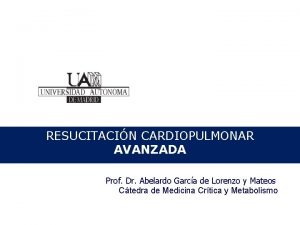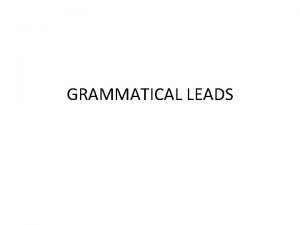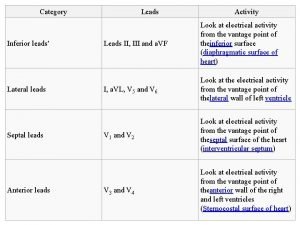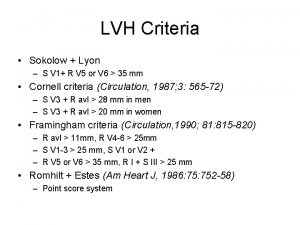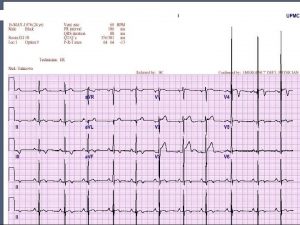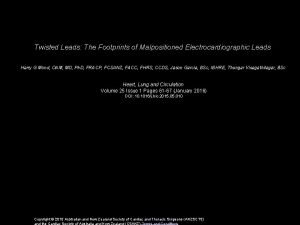test in tim LVH PVCs Precordial Leads KH




















- Slides: 20

test ®iÖn tim ®å

• LVH & PVCs: Precordial Leads KH

II V 1 • Left Atrial Enlargement KH • Left atrial enlargement is illustrated by increased P wave duration in lead II, top ECG, and by the prominent negative P terminal force in lead V 1, bottom tracing

• LVH Best seen in the frontal plane leads! KH Lewis Index: 1) R in a. VL >11 mm 2) R in I + S in III >25 mm 3) (RI+SIII) (RIII+SI) >17 mm

• Right Atrial Enlargement (RAE) & Right Ventricular Hypertrophy (RVH) KH • RAE is recognized by the tall (>2. 5 mm) P waves in leads II, III, a. VF. RVH is likely because of right axis deviation (+100 degrees)

• Left Atrial Abnormality & 1 st degree AV Block KH • Sãng P réng (>0, 12 s) vµ cã khÝa ë DII, DIII; hai pha ë chuyÓn ®¹o V 1 – TÊt

• Severe RVH Trôc P râ (+150 degrees) D¹ng q. R ë V 1, R/S ë V 1 > 1; S/R ë V 6 > 1 ST chªnh dèc xuèng ë c¸c chuyÓn ®¹o tr íc

• LVH: Limb Lead Criteria KH • In this example of LVH, the precordial leads don't meet the usual voltage criteria or exhibit significant ST segment abnormalities. The frontal plane leads, however, show voltage criteria for LVH and significant ST segment depression in leads with tall R waves. The voltage criteria include 1) R in a. VL >11 mm; 2) R in I + S in III >25 mm; and 3) (RI+SIII) (RIII+SI) >17 mm (Lewis Index).

• Left Atrial Enlargement: Leads II and V 1 KH

• RAE & RVH KH

• Left Atrial Abnormality & 1 st Degree AV Block: Leads II and V 1 KH P > 0, 12 s vµ cã khÝa ë DII; hai pha ë chuyÓn ®¹o V 1

• Left Atrial Enlargement & Nonspecific ST T Wave Abnormalities KH • LAE is best seen in V 1 with a prominent negative (posterior) component measuring 1 mm wide and 1 mm deep. There also diffuse nonspecific ST T wave abnormalities which must be correlated with the patient's clinical status. Poor R wave progression in leads V 1 V 3, another nonspecific finding, is also present

• LVH and Many PVCs KH • The combination of voltage criteria (SV 2 + RV 6 >35 mm) and ST T abnormalities in V 5 6 are definitive for LVH. There may also be LAE as evidenced by the prominent negative P terminal force in lead V 1. Isolated PVCs and a PVC couplet are also present.

• Right Axis Deviation & RAE (P Pulmonale): Leads I, III KH

• LVH: Limb Lead Criteria KH Lewis Index: 1) R in a. VL >11 mm 2) R in I + S in III >25 mm 3) (RI+SIII) (RIII+SI) >17 mm

• LVH: Strain pattern + Left Atrial Enlargement KH SV 2 + RV 5 >35 mm Sãng P réng (>0. 12 s) vµ cã khÝa ë DII, DIII; hai pha ë

• RVH with Right Axis Deviation • Note the q. R pattern in right precordial leads. This suggests right ventricular pressures greater than left ventricular pressures. The persistent S waves in lateral precordial leads and the RAD are other finding in RVH.

• LVH with "Strain" KH SV 2 + RV 5 >35 mm Lewis Index: 1) R in a. VL >11 mm 2) R in I + S in III >25 mm 3) (RI+SIII) (RIII+SI) >17 mm

• Right Ventricular Hypertrophy (RVH) & Right Atrial Enlargement (RAE) KH • In this case of severe pulmonary hypertension, RVH is recognized by the prominent anterior forces (tall R waves in V 1 2), right axis deviation (+110 degrees), and "P pulmonale" (i. e. , right atrial enlargement). RAE is best seen in the frontal plane leads; the P waves in lead II are >2. 5 mm in amplitude

Xin tr©n träng c¸m ¬n !
 Precordial leads
Precordial leads Precordial leads
Precordial leads Precordial leads
Precordial leads Sinus rhythm with couplets
Sinus rhythm with couplets What causes junctional rhythm
What causes junctional rhythm Sokolow lyon criteria
Sokolow lyon criteria Anne vallersnes
Anne vallersnes Watch?v=0evgft8hgns
Watch?v=0evgft8hgns Pathologic q wave
Pathologic q wave Precordial thump
Precordial thump Precordium inspection
Precordium inspection Precordial catch syndrome
Precordial catch syndrome Probabilidad pretest angina
Probabilidad pretest angina Dolor precordial tipico y atipico
Dolor precordial tipico y atipico Actividad electrica sin pulso
Actividad electrica sin pulso Road terminology
Road terminology National tim responder training test answers
National tim responder training test answers Fdot mot training questions and answers
Fdot mot training questions and answers Types of claims activity
Types of claims activity Blind identification lead
Blind identification lead A movable plate that covers the shuttle
A movable plate that covers the shuttle
